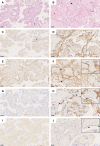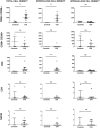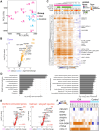Histologic and molecular features shared between antibody-mediated rejection of kidney allografts and chronic histiocytic intervillositis support common pathogenesis
- PMID: 40178007
- PMCID: PMC12056277
- DOI: 10.1002/path.6413
Histologic and molecular features shared between antibody-mediated rejection of kidney allografts and chronic histiocytic intervillositis support common pathogenesis
Abstract
Chronic histiocytic intervillositis (CHI) is an inflammatory condition of the placenta, characterised by an abnormal, mainly macrophagic infiltrate within the intervillous space. Recent research suggests that CHI results from a 'maternal-foetal rejection' mechanism, because at least some CHI cases fulfil the criteria for antibody-mediated rejection (AMR) of kidney allografts according to the Banff classification [i.e. presence of anti-human leukocyte antigen (HLA) paternal antibodies activating the complement or foetal-specific antibodies (FSA), a macrophage-rich infiltrate, and positive C4d immunostaining]. To gain further insights into CHI pathogenesis, we aimed to refine the phenotype of the inflammatory infiltrate using a multiplex immunofluorescence technique and to compare the mRNA signatures between CHI and AMR of kidney allografts. Twelve patients with C4d+ FSA+ CHI were included in the study and compared to a control group of 5 patients without inflammatory lesions on placental examination. We developed a multiplex immunofluorescence panel to identify CD4+ and CD8+ T lymphocytes, CD68+/CD206- and CD68+/CD206+ macrophages, and NK cells in the villi and intervillous space. Molecular signatures were studied using NanoString® technology and the B-HOT panel recommended by the Banff classification for kidney allografts. Multiplex immunofluorescence revealed that the infiltrate in the intervillous space was mainly composed of CD68+/CD206- macrophages as well as a higher proportion of CD8+ lymphocytes in patients with CHI compared to controls. Densities of NK cells and CD4 T cells were very low. Molecular signatures showed an overexpression of HLA class II genes, an IFN-γ signature, and cytokine gene sets in C4d+ FSA+ CHI patients, also involved in kidney AMR. These results reinforce the paradigm of maternal-foetal rejection. © 2025 The Author(s). The Journal of Pathology published by John Wiley & Sons Ltd on behalf of The Pathological Society of Great Britain and Ireland.
Keywords: M1 type macrophages; chronic histiocytic intervillositis; maternal‐foetal rejection; molecular signatures; multiplex immunofluorescence.
© 2025 The Author(s). The Journal of Pathology published by John Wiley & Sons Ltd on behalf of The Pathological Society of Great Britain and Ireland.
Figures





References
-
- Schwartz DA, Baldewijns M, Benachi A, et al. Hofbauer cells and COVID‐19 in pregnancy. Arch Pathol Lab Med 2021; 145: 1328–1340. - PubMed
-
- Labarrere C, Mullen E. Fibrinoid and trophoblastic necrosis with massive chronic intervillositis: an extreme variant of villitis of unknown etiology. Am J Reprod Immunol Microbiol 1987; 15: 85–91. - PubMed
-
- Bos M, Nikkels PGJ, Cohen D, et al. Towards standardized criteria for diagnosing chronic intervillositis of unknown etiology: a systematic review. Placenta 2018; 61: 80–88. - PubMed
MeSH terms
Grants and funding
LinkOut - more resources
Full Text Sources
Medical
Research Materials

